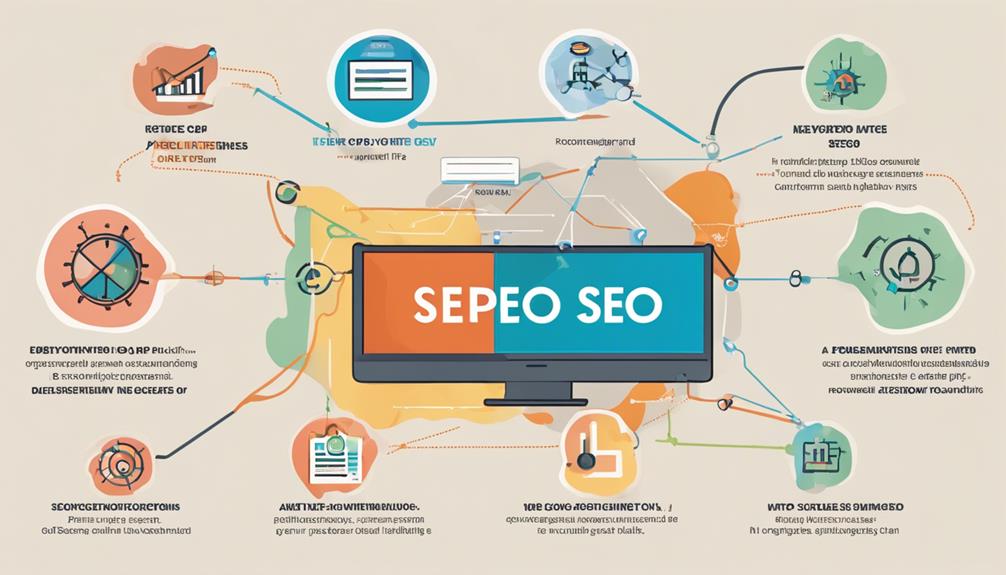
Embarking on the journey of optimizing your webpage for better search engine rankings is akin to navigating through a dense forest with a map in hand. As you tread through the intricate world of on-page SEO, each step reveals new insights and challenges.
Unravel the secrets of boosting your online visibility with the latest tips and strategies. Let's explore how you can harness the power of on-page SEO to elevate your digital presence and outshine the competition in 2021.
Key Takeaways
- Optimize content with proper header tags and engaging, valuable information.
- Craft compelling title and meta tags with relevant keywords for SEO impact.
- Enhance heading structure with keyword incorporation and clear guidance for users.
- Refine URL structure by including primary keywords and organizing content hierarchy for better performance.
Page Content Optimization
To enhance your website's search engine visibility and overall performance, mastering the art of page content optimization is crucial in 2021. This process involves a strategic approach to utilizing on-page SEO factors such as header tags, internal and external links, keyword research, schema markup, meta tags, image optimization, and internal links. Conducting a data audit and content audit can provide valuable insights into areas that need improvement and optimization.
When optimizing your page content, it's essential to pay close attention to the proper use of header tags. Incorporating H1, H2, and other header tags not only helps organize your content for readers but also assists search engines in understanding the hierarchy and relevance of the information presented. Additionally, including relevant internal and external links within your content can significantly impact your SEO performance by enhancing credibility and authority.
Furthermore, optimizing images with descriptive alt text and file names contributes to a better user experience and can positively influence search engine rankings. By focusing on creating engaging and valuable content that aligns with user intent, you can drive organic traffic to your webpage and improve your on-page SEO success.
Title Tags and Meta Tags
When optimizing your website, remember that title tags serve as the first impression in search results, impacting user clicks.
Crafting compelling meta tags with relevant keywords can enhance your search visibility and user engagement levels.
Utilize these tags strategically to improve your on-page SEO and overall website performance.
Importance of Title Tags
Amidst the ever-evolving landscape of digital marketing, delving into the significance of title tags and meta tags unveils crucial insights for enhancing on-page SEO strategies in 2021.
Title tags, as essential HTML elements, play a pivotal role in search engine results by acting as clickable headlines that can significantly impact click-through rates. It's vital to craft concise title tags of 50-60 characters length with primary keywords to boost SEO benefits.
Furthermore, meta tags, including meta descriptions, offer additional information about webpages, influencing user engagement and search engine rankings. By optimizing these elements, you can improve visibility, enhance user experience, and drive organic traffic, ultimately contributing to on-page SEO success.
Crafting Effective Meta Tags
Crafting compelling meta tags, including title tags and meta descriptions, is a critical element for achieving success in on-page SEO strategies. Title tags should be concise, around 50-60 characters, to ensure they appear correctly in search results. Meta descriptions, approximately 150-160 characters, play a vital role in attracting clicks by being relevant and engaging. Incorporating target keywords in these meta tags helps search engines comprehend the webpage's content, enhancing visibility on search engine results pages. Well-crafted meta tags can significantly impact click-through rates, driving more traffic to your site. By creating compelling meta descriptions, you increase the chances of enticing users to click on your link, ultimately boosting your website's performance.
| Meta Tag Type | Character Length | Importance |
|---|---|---|
| Title Tags | 50-60 characters | Ensure proper display in search results |
| Meta Descriptions | 150-160 characters | Attract clicks from searchers |
| Target Keywords | Inclusion | Help search engines understand webpage content |
SEO Benefits of Tags
To maximize the effectiveness of your on-page SEO efforts, understanding the SEO benefits of tags, specifically title tags and meta tags, is crucial for improving your website's visibility and performance in search engine results.
Title tags play a significant role as they're the first thing users see in search results, impacting click-through rates. Meta tags provide essential information to search engines, influencing how pages are indexed and displayed. Including relevant keywords in these tags can enhance a webpage's visibility and ranking.
Optimizing title and meta tags can result in higher organic traffic, increased user engagement, and improved conversions. Properly structured data in tags can also enhance SEO performance, making your site stand out in Google's structured data markup and search results.
Conducting regular audits of these factors is a best practice using Google's structured data testing tool.
Heading Structure Enhancement
Enhance your website's heading structure for improved readability and SEO performance by utilizing proper H1, H2, and H3 tags. When optimizing your headings, consider the following:
- Keyword Placement: Incorporate relevant keywords in your headings to signal content relevance to search engines.
- Content Organization: Headings provide a clear structure, guiding users through your content and improving navigation.
- User Engagement: Structured headings enhance user experience, making it easier for visitors to consume information.
- Consistency: Maintain a consistent heading structure across web pages for better organization and SEO effectiveness.
- SEO Impact: Well-structured headings not only enhance user experience but also contribute to improved search engine rankings.
URL Structure Refinement
Improving your website's URL structure is crucial for boosting both user engagement and search engine visibility. Structuring URLs based on content hierarchy aids in website organization and navigation, leading to better user understanding and increased search engine relevance. When refining your URL structure, consider using primary keywords to enhance click-through rates, opting for descriptive and concise URLs for improved performance, and choosing hyphens over underscores for better readability and SEO benefits. By aligning your URL structure with on-page SEO best practices and internal linking strategies, you can optimize your website for both users and search engines. Below is a table highlighting the importance of URL structure refinement:
| Key Points | Importance |
|---|---|
| Inclusion of primary keywords | High |
| Descriptive and concise URLs | Medium |
| Hyphens over underscores | Medium |
| Content hierarchy structuring | High |
| User understanding and SEO | High |
Alt Text Optimization
When optimizing alt text for your images, consider the importance of providing accurate and descriptive information that aligns with the image content. Utilize relevant keywords in your alt text to boost visibility in image search results and help search engines understand the context of your images.
Remember that concise, clear, and relevant alt text not only benefits visually impaired users but also enhances your on-page SEO efforts.
Image Alt Tag Importance
Optimizing image alt tags, also known as alt text, plays a crucial role in enhancing website accessibility and improving overall on-page SEO performance. When focusing on Image Alt Tag Importance, consider the following:
- Image alt text helps visually impaired users understand webpage content.
- Improving image SEO through keyword optimization in alt text can boost visibility in image search results.
- Alt tags are essential for accessibility compliance, making websites more inclusive.
- Search engines rely on alt text to index images, impacting overall on-page SEO efforts.
- Well-optimized alt tags enhance user experience, potentially reducing bounce rates and increasing organic traffic.
Optimizing Alt Text
Alt text optimization is a critical aspect of enhancing website accessibility and improving on-page SEO performance in 2021.
When optimizing alt text for images, it's crucial to consider both accessibility for visually impaired users and the SEO benefits it offers.
By including relevant keywords in the alt text, you can improve image SEO and help search engines better understand the context of the image.
A well-crafted alt text should provide a clear and concise description of the image without resorting to keyword stuffing.
This optimization not only enhances user experience by making the content more accessible but also strengthens your on-page SEO strategy, ultimately increasing visibility on search engines.
Alt Text Best Practices
Considering the importance of accurate and descriptive image attributes, optimizing alt text is a fundamental aspect of enhancing website accessibility and maximizing on-page SEO performance in 2021. When crafting alt text, keep these best practices in mind:
- Ensure alt text is concise yet descriptive.
- Use relevant keywords to improve image SEO.
- Accurately reflect the content and purpose of the image.
- Enhance accessibility for visually impaired users.
- Elevate user experience and search engine visibility.
Page Load Speed Improvement
Improving page load speed is essential for enhancing user experience and boosting search engine rankings. A fast-loading website not only improves user engagement but also helps minimize bounce rates, a crucial factor for SEO success. Utilizing tools like Google PageSpeed Insights can provide valuable insights into areas needing improvement. Strategies such as image optimization, reducing HTTP requests, and implementing browser caching are instrumental in load time optimization.
Mobile optimization is a key aspect to consider, given the increasing number of users accessing websites via mobile devices. Ensuring that mobile pages load quickly is imperative for retaining visitors and improving user engagement. Slow-loading mobile pages can deter users and negatively impact search engine rankings. By prioritizing mobile page load speed alongside desktop load times, you can create a seamless browsing experience for all users, leading to improved overall performance and search engine visibility.
Mobile-Friendly Optimization
Mobile-friendly optimization is a pivotal factor in enhancing website performance and securing higher search engine rankings in today's digital landscape. When it comes to mobile optimization, consider the following key points:
- Google prioritizes: Ensuring your website is mobile-friendly is crucial for Google's ranking algorithms.
- Over 50% of web traffic: With more than half of web traffic coming from mobile devices, optimizing for mobile is essential to reach a wider audience.
- Loading times: Mobile users expect fast loading times, and delays can lead to a high bounce rate.
- Responsive web design: Implementing responsive design guarantees a seamless user experience across all devices and screen sizes.
- Conversions: Mobile optimization can significantly impact conversions, as users are less likely to engage with sites that offer a poor mobile experience.
Are the On-Page SEO Analysis Tips in 2021 Still Relevant in the Updated Guide?
Yes, onpage SEO analysis techniques are still relevant in the updated 2021 guide. It is crucial to optimize website content, meta descriptions, and headings for better search engine rankings. Pay attention to keyword placement, internal linking, and mobile-friendliness to improve onpage SEO performance.
Conclusion
You've learned valuable tips to optimize your on-page SEO in 2021. Did you know that 75% of users never scroll past the first page of search results?
By implementing the strategies outlined in this guide, you can improve your website's visibility and attract more organic traffic.
Remember to continuously monitor and adjust your SEO efforts to stay ahead of the competition and achieve your digital marketing goals.
- Writing Content That Converts Visitors Into Customers - 04/11/2025
- How to Plan a Content Calendar That Works - 29/10/2025
- SEO Content vs. Social Media Content: What’s the Difference? - 23/10/2025


